![]()
![]()
![]()
Use LEFT and RIGHT arrow keys to navigate between flashcards;
Use UP and DOWN arrow keys to flip the card;
H to show hint;
A reads text to speech;
11 Cards in this Set
- Front
- Back
- 3rd side (hint)
|
What diagnostic plan would be useful for skin lesions characterised by nodules, sinuses or non-healing wounds?
|
1 Full general and dermatological Hx
2 PE and dermatological exam 3 Problem list 4 Cytology of primary lesions, exudates, aspirates and regional lymph nodes. Inform the laboratory that an unusual organism is suspected . 5 Biopsy for histopathology o multiple specimens, do not prep the site o ideally a wedge incorporating normal tissue and fully developed lesion o request special stains Biopsy for culture and sensitivity o surgically prep the site and collect deep tissue aseptically o ideally sample open and closed lesions o request aerobic and anaerobic bacterial culture and fungal culture 6 Screen for systemic illness: • Blood and urine for CBC, biochemistry, urinalysis +/- serology eg LCAT. • Consider diagnostic imaging |
|
|
|
What are some differentials for skin lesions characterised by nodules, sinuses or non healing
wounds? |
• Bacterial
o Actinomycoses, Nocardiosis, pseudomycetoma o Mycobacteriosis, leproid granuloma • Fungal o Aspergillosis (blastomycosis, histoplasmosis, coccidiomycosis) o Cryptococcosis o Dermatophytosis o Opportunist fungal infections • Algal o protothecosis • Parasitic o Leishmaniasis o Neosporosis o Sarcocystosis o Parasitic larvae: dirofilariasis, habronemiasis • Non-infectious, inflammatory o foreign body o sterile nodular panniculitis o eosinophilic granuloma o sterile granuloma/ pyogranuloma syndrome o reactive histiocytosis • Neoplastic o malignant histiocytosis o mast cell tumour o perianal sebaceous adenoma/ carcinoma o lipoma o sebaceous adenoma/ hyperplasia o squamous cell carcinoma o melanoma o fibrosarcoma o basal cell tumour o haemangioma, haemangiosarcoma |
|
|
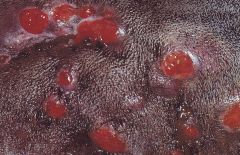
The lesions in this picture are caused by Actinomycosis. What are some clinical features associated with this disease and how would you diagnose and treat it?
|

Chronic, pyogranulomatous disease of dogs and cats
Actinomycetaceae are saprophytes of mucous membranes. Not normally pathogenic, but cause disease if innoculated into tissue Dog: nodules and sinuses in the skin and subcutis of the face, +/- osteomyelitis, pneumonia, mediastinitis, pyothorax and pleuritis, pericardial effusion, abdominal masses and peritoneal effusion, retroperitoneal masses and effusions +/- vertebral osteomyelitis cutaneous masses and draining sinuses Cat: pyothorax and subcutanous bite wound abscesses. |
Dx: lesions suppurative to pyogranulomatous
“Sulphur granules” may be visible macroscopically need to collect anaerobically and request special culture Histopathology: core of neutrophils and organisms surrounded by dense granulation tissue Tx: prolonged penicillin G or V & surgical debridement, irrigation and search for FB |
|

Which common soil saphrophyte could be the causative organism for this lesion?
What CS are associated with the resulting disease and how would you proceed to diagnose and treat? |
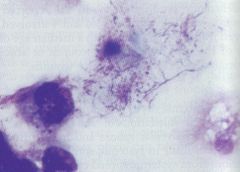
Nocardiaceae: Gram positive, partially acid fast filamentous bacteria, opportunistic pathogen esp. immunocompromised patients
uncommon in dogs, typically pulmonary (bronchopneumonia/mass lesions/pleural effusion), disseminated (with concuttent pulmonary infection) or cutaneous/subcutaneous -> firm to fluctuant swellings that may ulcerate or develop fistulous tracts with reddish-brown exudate +/- sulphur granules Feline nocardiosis occurs in the same three forms as dogs but most commonly as cutaneous/subcutaneous abscesses or mycetomas |
Dx: cytology-> suppurative to pyogranulomatous inflammation, C&S
Tx: sulphonamides so sulphonamide-trimethoprim is DoC 1-3m for skin lesions, up to 12m if disseminated or immuno compromised patient Lesions should be debrided, drained and lavaged |
|
|
Which 2 important syndromes are associated with cutaneous mycobacterial infections?
|
• canine feline leprosy (leproid granuloma) and
• mycobacterial panniculitis |
|
|

What do you know about canine and feline leproid granuloma?
|
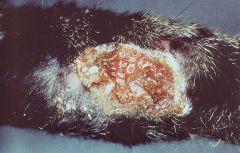
Single to multiple small (<4 mm) painless, raised, fleshy nodules occurring on pinnae, limbs and head
Dogs infected with MAC acquire a subclinical, progressive granulomatous disease of bowel, spleen, liver and mesenteric lymph nodes |
Dx: Cytology, histopathology with acid-fast/ ZN staining
Tx: Many cases are self-limiting with 3 months. Some progress >disfigurement. Surgical excision may be curative. rifampin plus clarithromycin or doxycycine may be used in severe or refractory cases |
|
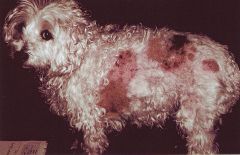
What is mycobacterial panniculitis?
|

chronic infection of subcutis and skin with rapidly growing
saprophytic mycobacteria RGM. Infection typically requires host immunocompromise and can result in mycobacterial panniculitis, pyogranulomatous pneumonia or disseminated disease Routine surgical debridement and empirical antibiotic therapy typically results in wound breakdown with development of a non-healing suppurative tract surrounded by granulation tissue. |
Dx: appropriately stained cytology of exudate or deep tissue
specimens in conjunction with culture. Tx: sensitivity essential, commence empirical therapy with high doses of doxycycline or cyprofloxacin initially whilst MC&S pending continue for 3-6 months and 1-2 months after clinical remission |
|

What disease is caused by the organism in this picture?
|

Sporotrichosis
nodules or non-healing wounds +/- draining tracts ZOONOTIC dimorphic fungus: mycelium at environmental temperatures and a yeast at body temperature. ubiquitous in soi l-> infection is by direct innoculation from thorns, splinters or contaminated claws |
Dx: cytology, culture of deep exudate or tissue
Tx: dogs: potassium iodide cats: itraconazole corticosteroids contraindicated |
|
|
Which systemic mycosis is associated with dermatological signs in Australia?
|
Cryptococus neoformans
disease in immunocompromised patients, eg. FIV CS: upper respiratory with sneezing, snuffling, stertor, nasal discharge, a visible granulomatous polyp and/or swellling over the bridge of the nose. Cutaneous lesions elsewhere are characterised by multiple papules or nodules that may ulcerate, on face, pinnae and paws may have CNS and occular involvement |
Dx: nasal exudate, BAL, CSF, aqueous/vitreous, or FNA of nodules or enlarged lymph nodes. Stain with New Methylene Blue, Diff Quik or Gram to demonstrate the large unstained capsule. C&S
Tx: amphotericin B for severe or neurologicaldisease; itraconazole, fluconazole, |
|
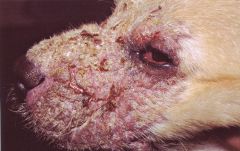
This uncommon, oedematous, vesicopustular dermatitis primarily affects the skin around the mouth, eyes and pinnae of puppies
|
Canine juvenile cellulitis
non-infectious, mutiple granulomatous or pyogranulomatous lesions |
|
|
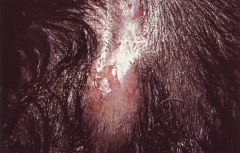
What describes the term panniculitis? How would you diagnose a nodular panniculitis?
|

general term for inflammation of subcutaneous fat
single or multiple subcutaneous nodules, localised or generalised, up to several cm in diameter. Nodules may be firm or fluctuant and may ulcerate or exhibit draining tracts with oily to haemorrhagic exudate. Dx of exclusion |
|

